- Elverum station, Hamar-Grundset Line, ca 1870.
- Hønefoss station on the Randsfjorden Line, 1900.
- This article is part of the history of rail transport by country series
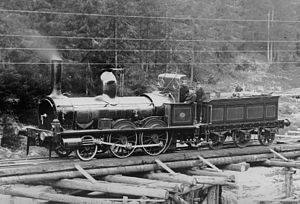
The history of rail transport in Norway had begun by 1805.

The history of rail transport in Norway had begun by 1805.
Norway's first railway is believed to have been the 1,400 m (4,593 ft) long horse-powered Damtjern-Storflåtan railway on Krokskogen, which was part of a longer route for timber transport from Land and Valdres to Oslo. The line was opened in 1805 and probably closed in 1849. [1]
The next line was probably the one built on Blaafarveværket in the 1820s, by the German miner Karl Friedrich Böbert. This was a mine railway with its rails laid on cast iron sleepers. It was operated by horses and used to transport ore.
About the same time, the 1,200 m (3,937 ft) long Gjøsbubanen was built on Otteidanlegget in Mark Østfold. This was a combined canal and railway construction that made possible the transport of timber between the Store Le and Øymarksjøen lakes. Initially, the wagons were drawn up by a device operated by horses or oxen. From 1854, power was supplied by a stationary steam engine. The track was in use from 1825 to 1926. [2]
Mortsjølungen-Tvillingtjern-banen (also known as the Grasmo Line) was a similar short line for the transport of timber between two rivers, namely the Mangenvassdraget and the Haldenvassdraget. The line was opened in 1849 and was in operation until 1931. At first, the wagons on this line were pulled by horses. From 1918, a motorized pulley was used. [3] The line was about 1,400 m (4,593 ft) long.
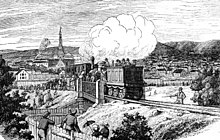
The first public railway in Norway was the Norsk Hoved-jernbane (also known as the Trunk Line). Work on this line was led by the Englishman Robert Stephenson, son of George Stephenson, who had constructed the first public railway in the world. [4]
The Trunk Line ran from Oslo to Eidsvold. Its main purpose was to transport lumber from Mjøsa to the capital, but also passenger services were operated. Construction of the line started in 1851 and it was opened on 1 September 1854.
Finance for the Trunk Line was raised by issuing 2.2 million shares for Norwegian speciedaler. Half the capital was provided by British shareholders and the other half by Norwegian interests, of which the State accounted for just over half. [5]
The Trunk Line was until 1926 a corporation in which over the years the State acquired more and more of the shares. It was therefore formally a private company, and did not become part of the Norwegian State Railways (Norwegian : Norges Statsbaner) until 4 March 1926. [6]
The section between Kristiania East and Lillestrøm was rebuilt as a double track line in 1902, and the line as a whole was electrified in two portions, in 1927 and 1953. The Trunk Line was the main line between Oslo and Eidsvoll until 8 October 1998, when the more direct, double-tracked high-speed Gardermoen Line opened, taking away most of the passenger traffic.

After the opening of the Trunk Line, there was interest in the development of public railways in several places in Norway.
Initially, Norwegian public railways were proposed as one of a number of steps in a longer transport route, combined with transport by sea. For example, the Trunk Line connected Oslo with steamboats on Lake Mjøsa, allowing steam powered transport to places like Lillehammer, 180 km from Oslo. Similar considerations were the basis for several of the new lines authorised by the Parliament of Norway from 1857.
During the construction period for these lines, which lasted until 1883, all new railways were State railways, organised as corporations. Private investors were invited to subscribe for shares that could provide dividends if there was a surplus. However, such investors were given no influence over the railway's operations. Rather, the Parliament insisted that it not only subscribe for a certain proportion of shares at the start of a project, but also have the power, at a later stage, to adopt the relevant line, and appropriate the remaining part of that line's initial capital.
In the years between 1862 and 1883, a series of more or less isolated lines was opened throughout southern Norway, including isolated railways in central and western Norway. The earliest railways were built to the 1,435 mm (4 ft 8+1⁄2 in) (standard gauge) but to reduce costs under the influence of Carl Pihl this was changed to 3 ft 6 in (1,067 mm). The height of the era came in 1877 when Røros Line connected Central Norway to the capital.
In 1883, there was a pause in the construction of several railways. The same year, a new administrative system was launched for the State railways, with a main administration in Christiania and six district administrations in Christiania, Drammen, Hamar, Trondheim, Stavanger and Bergen. The term "De norske Statsbaner" was adopted in 1883, and in December 1885 the term "Norges Statsbaner" was used for the first time. [7]
By the 1880s, after some mixed experiences with the model under which the Trunk Line was built, the State had control of Norwegian railway construction. However, a number of private public railways were opened in Norway between 1892 and 1956. Some of these were developed for the transport needs of individual businesses, while others were ordinary public railways to serve a specific district.
Private railways that were built for a specific company's needs remained in operation the longest. The remainder had, for the most part, already been closed during the interwar years, when they were ousted by road transport. [8]
The turnaround in railway construction after 1883 was criticized by many. In the previous two decades, Norway had gained national expertise in railway construction. When the construction was stopped, there was a risk that this expertise would be lost.
In the second half of the 1880s, Norway had no shortage of railway plans and wishes. However, the great building boom of the 1870s had been financed in large part by government borrowings abroad. From 1890, there was a willingness to resume the construction of railways. After a few years, a boom was in full swing again, and it was perhaps even more ambitious than ever.
Three urban railways, in Oslo, Bergen and Trondheim, were started as horsecar systems between 1875 and 1893. They were all electrified around the turn of the century.
The second construction boom of the main railway arose in the 1910s and included the Bergen Line across Finse to Bergen, connecting eastern and western Norway. Also a number of other larger projects were built through the 1920s, including a second line, the Dovre Line, to Trondheim. This period also saw the first electrified railways and a steady conversion from Cape gauge to standard gauge. Norway chose to electrify its rail network at 15 kV 16.7 Hz AC.
During World War II, the development of the network was a priority for the German occupation forces, as part of the creation of Festung Norwegen. Several lines were extended or constructed, with mostly poor quality results. In particular, the Nordland Line was extended a long distance to Dunderland, the Flåm Line was opened in 1941, and the entire Sørlandet Line was completed at Stavanger in 1944.
After the end of the war, the Nordland Line was extended all the way to Bodo. Upon the opening of that extension in 1962, Norwegian railway construction was complete, in the sense that all subsequent work can be regarded as modernization or capacity expansion of existing railways: Lieråstunnelen in 1973, Oslo Tunnel in 1980, Finse Tunnel in 1993, Ski–Sandbukta completed in 1996, the Gardermoen Line in 1998/1999, Gråskallen Tunnel on the Bergensbane in 1999, Kobbervik–Holm in 2001 and the Asker Line in 2005.
For most of the twentieth century, NSB had a near monopoly on rail operations in Norway. However, in 1996 the National Rail Administration (Jernbaneverket) was separated from the NSB, and given the task of maintaining the railway network. Since then, many different train companies have operated trains on the network.

The Norwegian railway system comprises 4,109 km of 1,435 mm track of which 2,644 km is electrified and 274 km double track. There are 697 tunnels and 2,760 bridges.

The Bergen Line or the Bergen Railway, is a 371-kilometre (231 mi) long scenic standard gauge railway line between Bergen and Hønefoss, Norway. The name is often applied for the entire route from Bergen via Drammen to Oslo, where the passenger trains go, a distance of 496 kilometres (308 mi). It is the highest mainline railway line in Northern Europe, crossing the Hardangervidda plateau at 1,237 metres (4,058 ft) above sea level.

The Røros Line is a 383-kilometer (238 mi) railway line which runs through the districts of Hedmarken, Østerdalen and Gauldalen in Innlandet and Trøndelag, Norway. The line branches off from the Dovre Line at Hamar Station and runs a more easterly route to Støren Station, where the two lines meet again. The Røros Line also intersects with the Solør Line at Elverum Station. The single track, standard gauge line lacks electrification and only has centralized traffic control south of Røros Station. SJ Norge operate regional passenger trains. In addition the line is used by freight trains hauling lumber and wood chippings.

The Dovre Line is a Norwegian railway line with three slightly different lines which all lead to the historic city of Trondheim.

The Nordland Line is a 729-kilometer (453 mi) railway line between Trondheim and Bodø, Norway. It is the longest in Norway and lacks electrification. The route runs through the counties of Trøndelag and Nordland, carrying a combination of commuter, long-haul passenger and freight trains. From Trondheim Central Station to Steinkjer Station the line is most heavily used, with hourly services by the Trøndelag Commuter Rail. There are three branch lines—the Stavne–Leangen Line at Leangen Station, the Meråker Line at Hell Station and the Namsos Line at Grong Station.

Trondheim Central Station or Trondheim S is the main railway station serving the city of Trondheim, Norway. Located at Brattøra in the north part of the city centre, it is the terminus of the Dovre Line, running southwards, and the Nordland Line, which runs north. The railway is electrified south of the station but not north of it, so through trains must change locomotives at the station.

The Solør Line is a 93.6-kilometer (58.2 mi) railway line that runs through district of Solør in Innlandet county, Norway. The line connects the Kongsvinger Line at Kongsvinger Station with the Røros Line at Elverum Station, running through the municipalities of Kongsvinger, Grue, Åsnes, Våler and Elverum. The standard gauge line lacks electrification and centralized traffic control; it is solely used by freight trains, mostly hauling lumber and wood chippings.

Asker Station is a railway station located in downtown Asker, Norway. Situated on the Drammen Line, 23.83 kilometers (14.81 mi) from Oslo Central Station, it also serves as the terminus of the Asker Line and the Spikkestad Line. The station is located just southwest of the Asker Tunnel and the Skaugum Tunnel, and just northeast the Lieråsen Tunnel. Vy serves the station with local, regional and intercity trains. It is also served by the Airport Express Train and serves as the main bus terminal for the town. The station has six tracks and four platforms, consisting of two island platforms and two side platforms. The station had 8,400 daily passengers in 2008.
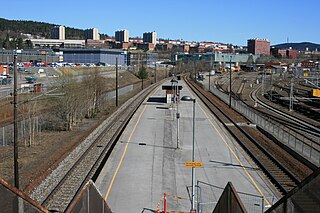
Alna Station is a railway station on the Trunk Line located at Alnabru in the Alna borough of Oslo, Norway. Situated 6.87 kilometers (4.27 mi) from Oslo Central Station, it consists of an island platform along a double tracked line. Alna is served by the L1 line of the Oslo Commuter Rail. The station was opened on 7 June 1971, replacing Alnabru Station. The former was dismantled to make room for Alnabru Freight Terminal. The station serves mostly an industrial area.

Hamar Station is a railway station of the Dovre Line and the Røros Line located in downtown Hamar, Norway. Located 126.26 kilometers (78.45 mi) from Oslo Central Station, it is served by long-distance and regional trains on the Dovre Line, as the terminus for regional trains on the Røros Line. All trains are operated by SJ Norge, except the regional trains between Lillehammer and Oslo, which are operated by Vy. A side platform and an island platform are in regular use. The station handled 1,062,300 passengers in 2008.
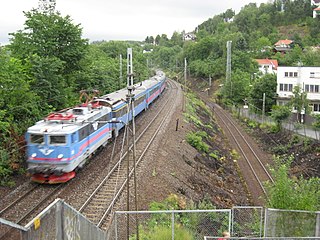
The Loenga–Alnabru Line is a 7.3-kilometer (4.5 mi) freight-only railway line in Oslo, Norway. It runs from the classification yard at Loenga(Norway) to Alnabru Freight Terminal, typically serving twenty trains per day. It allows trains to pass from the Østfold Line to Alnabru without passing via Oslo Central Station. It is also used by freight trains from the Sørlandet Line, which run via the Oslo Tunnel and cross over at Bryn Station. It is notorious for the steep hill Brynsbakken which it has to climb, giving it a gradient of 2.6 percent.

Grorud Station is a railway station on the Trunk Line located in the Grorud borough of Oslo, Norway. Situated 10.50 kilometers (6.52 mi) from Oslo Central Station, it consists of three tracks with a side platforms and an island platform. Grorud is served by the L1 line of the Oslo Commuter Rail.

Haugenstua Station is a railway station on the Trunk Line located in the Haugenstua neighborhood of Oslo, Norway. Situated 12.09 kilometers (7.51 mi) from Oslo Central Station, it consists of two side platforms along a double tracked line and a disused station building. Haugenstua is served by the L1 line of the Oslo Commuter Rail. The station was opened on 1 December 1937 and received a major renovation in 2007. It has about 3,200 daily passengers.

Stabekk Station is a railway station of the Drammen Line situated at Stabekk in Bærum, Norway. Located 8.99 kilometers (5.59 mi) from Oslo Central Station, it is served by line L1, L2, L2x and L21 of the Oslo Commuter Rail and by Flytoget - the express train to Oslo Airport. It is located in a primarily residential area and has four regular hourly services operated by Vy. The station features an island platform accessible from the station building on the south side.
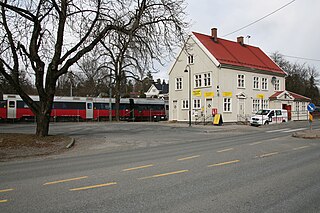
Blommenholm Station is a railway station of the Drammen Line situated at Blommenholm in Bærum, Norway. Located 12.23 kilometres (7.60 mi) from Oslo Central Station, it is served by line L1 of the Oslo Commuter Rail. It is located in a primarily residential area and has four regular hourly services operated by Vy. The station features an island platform accessible from the station building on the south side.
Timeline of transport in Oslo covers key incidents within transport in Oslo, the capital of Norway.
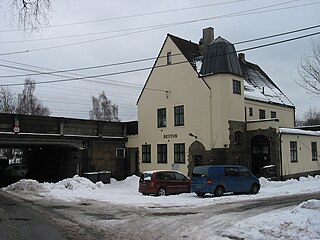
Bestun Station was a railway station situated at Bestum of the Ullern area of Oslo, Norway, on the Drammen Line. The station, located 4.31 kilometers (2.68 mi) from Oslo West Station (Oslo V), was served by Oslo Commuter Rail trains of the Norwegian State Railways.

The Norwegian railway network consists of 2,552 kilometers (1,586 mi) of electrified railway lines, constituting 62% of the Norwegian National Rail Administration's 4,114 kilometers (2,556 mi) of line. The first three mainline systems to be electrified were private ore-hauling lines. The Thamshavn Line opened in 1909, and remained in revenue use until 1973, after which it was converted to a heritage railway. It is the world's oldest remaining alternating-current railway and the only narrow gauge railway in the country to have been electrified. It was followed by Norsk Transport's Rjukan and Tinnoset Lines two years later, and Sydvaranger's Kirkenes–Bjørnevatn Line in 1922. The Norwegian State Railways' (NSB) first electrification was parts of the Drammen Line in 1922 and the ore-hauling Ofoten Line, which connects to the Iron Ore Line in Sweden, in 1923. The use of El 1 locomotives on the Drammen Line proved a large cost-saver over steam locomotives, and NSB started electrifying other lines around Oslo; from 1927 to 1930, the remainder of the Drammen Line and the continuation along the Randsfjorden and Sørlandet Lines to Kongsvinger were converted, along with the first section of the Trunk Line. In 1935, the Hardanger Line became the first section of new NSB track to be electrified. From 1936 to 1940, NSB electrified the Østfold Line, as well as more of the Sørland Line and the Bratsberg Line, connecting all electric lines west of Oslo.
Gulfoss Tunnel is a 701-meter (2,300 ft) railway tunnel situated in the municipality of Melhus in Trøndelag county, Norway. The tunnel runs beneath the village of Hovin, alongside the river Gaula past the Gulfossen waterfall. The tunnel carries a single, electrified track of the Dovrebanen railway line. The Trondhjem–Støren Line, which opened in 1864, crossed the river Gaula on a bridge to the opposite side of the river at the current site of the tunnel. This section of track was a challenge due to regular flooding. With the 1908 decision to build the Dovrebanen Line and gauge conversion, the Gulfossen section became one of two parts of the line to be reworked. Gulfoss Tunnel opened on 6 July 1918.
![]() Media related to History of rail transport in Norway at Wikimedia Commons
Media related to History of rail transport in Norway at Wikimedia Commons